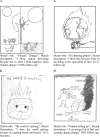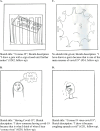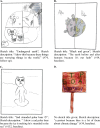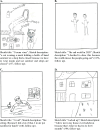From anxiety to coping: Understanding psychological distance and coping skills for climate change and COVID-19 in 10-12-year-old children
- PMID: 39908312
- PMCID: PMC11798500
- DOI: 10.1371/journal.pone.0317725
From anxiety to coping: Understanding psychological distance and coping skills for climate change and COVID-19 in 10-12-year-old children
Abstract
Children worldwide experience climate anxiety, defined as a chronic fear of environmental catastrophe. Following other scholars who sought comparison between the perceived risks and our collective responses with the COVID-19 pandemic, as they can both be considered global crises. Children's emotional responses, psychological distance and coping strategies to climate change compared and COVID-19 are compared, using a mixed-method longitudinal study among 231 primary school children across the Republic of Ireland. Pre-pandemic and post-lock down data were collected measuring children's emotions through surveys using Likert scales and sketches. Sketching, increasingly recognised as a method for assessing emotional expression, is especially useful when language skills are limited. Results suggest that because climate change was more psychologically distant than COVID-19, it was more difficult for children to effectively use emotional-, meaning-, problem-, and relationship-focused coping strategies to deal with their climate anxiety. One important conclusion of this study is that messages and strategies used to motivate adults to take climate action may increase climate anxiety among young children. Also, relationship-focused coping strategies are underutilised to help children deal with climate anxiety, whilst these were promising coping mechanisms during the COVID-19 pandemic. Therefore, creating positive social support and collective action may help young children to cope with climate anxiety.
Copyright: © 2025 Schuitema, Lacchia. This is an open access article distributed under the terms of the Creative Commons Attribution License, which permits unrestricted use, distribution, and reproduction in any medium, provided the original author and source are credited.
Conflict of interest statement
The authors have declared that no competing interests exist.
Figures






Similar articles
-
Coping Strategies Among Healthcare Workers During the COVID-19 Pandemic: Emotional Responses, Challenges, and Adaptive Practices.Medicina (Kaunas). 2025 Feb 11;61(2):311. doi: 10.3390/medicina61020311. Medicina (Kaunas). 2025. PMID: 40005428 Free PMC article.
-
Left-behind children's social adjustment and relationship with parental coping with children's negative emotions during the COVID-19 pandemic in China.Int J Psychol. 2021 Aug;56(4):512-521. doi: 10.1002/ijop.12754. Epub 2021 Mar 19. Int J Psychol. 2021. PMID: 33739446 Free PMC article.
-
Maternal Distress/Coping and Children's Adaptive Behaviors During the COVID-19 Lockdown: Mediation Through Children's Emotional Experience.Front Public Health. 2020 Nov 19;8:587833. doi: 10.3389/fpubh.2020.587833. eCollection 2020. Front Public Health. 2020. PMID: 33330330 Free PMC article.
-
Post-pandemic student mental health and coping strategies: A time trajectory study.J Affect Disord. 2025 May 1;376:260-268. doi: 10.1016/j.jad.2025.02.007. Epub 2025 Feb 8. J Affect Disord. 2025. PMID: 39929277
-
Das „innere Klima“ regulieren in Zeiten globaler Erwärmung.Prax Kinderpsychol Kinderpsychiatr. 2025 May;74(4):371-383. doi: 10.13109/prkk.2025.74.4.371. Prax Kinderpsychol Kinderpsychiatr. 2025. PMID: 40400150 Review. German.
References
-
- Thompson T. Young people’s climate anxiety revealed in landmark survey. Nature. 2021;597(7878):605–605. doi: 10.1038/d41586-021-02582-8 - DOI
-
- Galway LP, Field E. Climate emotions and anxiety among young people in Canada: a national survey and call to action. J Clim Chang Health. 2023;9:100204. doi: 10.1016/j.joclim.2023.100204 - DOI
-
- Hickman C, Marks E, Pihkala P, Clayton S, Lewandowski RE, Mayall EE, et al.. Climate anxiety in children and young people and their beliefs about government responses to climate change: a global survey. Lancet Planet Health. 2021;5(12):e863–73. Epub 2021/12/14. doi: 10.1016/S2542-5196(21)00278-3 - DOI - PubMed
-
- Tucci J, Mitchell J, Goddard C. Children’s fears, hopes and heroes: modern childhood in Australia. Australian Childhood Foundation; 2007.
MeSH terms
LinkOut - more resources
Full Text Sources
Medical

